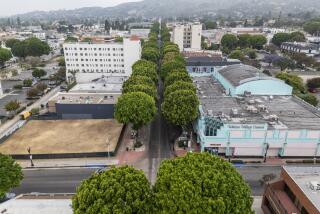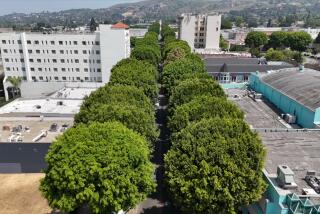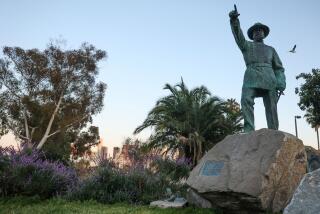‘Investors’ chip in for a piece of the rock that will introduce John Greenleaf Whittier to his namesake.
Christoph Rittershausen is selling shares of his dream. Twenty-five dollars will buy a piece of what has become known as Rittershausen’s rock, a larger-than-life-size concrete statue of John Greenleaf Whittier, the noted 19th- Century poet and Quaker for whom the City of Whittier is named.
Completing the sculpture in time for Whittier’s 100th birthday on May 9 has been Rittershausen’s mission--some say obsession--for three years.
When city fathers chose not to underwrite the project, the German-born wood carver and a band of backers went public in search of money. Like a new business short on capital, they decided to offer shares--limited partnerships of sorts--to attract investors. The shares are really donations, but those who contribute will get something akin to a stock certificate--a print of the statue signed by Rittershausen.
The strategy has paid handsome dividends. Almost half of the $30,000 needed to finish the sculpture and place it in Central Park has been raised, and most of it has come from “small investors,” committee member Judy Jansen said.
“The residents of Whittier,” she said, “are rallying around this project . . . . This is a birthday present that will be here long after the celebration, the parades and all the hoopla is over.”
Rittershausen, 39, is delighted. For years, he has tinkered with the notion of doing a sculpture for a park in the town he calls home.
“It’s a simple ego thing . . . ,” said Rittershausen, a 15-year resident of Whittier. “One of my little dreams is making sculptures for the outside.”
Producing something of lasting value, a piece that might be around when the city celebrates its bicentennial, is understandable considering the disposable nature of some of Rittershausen’s recent works.
He has carved a reputation as one of the movie industry’s best sculptors, as his recent Hollywood credits attest. He created a 17-foot-high Buddha in the recent Eddie Murphy film “The Golden Child,” and he had a hand in shaping a 40-foot-long whale in “Star Trek IV: The Voyage Home.” Both creations were done in Styrofoam, and once filming ended, they were chopped up and discarded.
It is no wonder Rittershausen would like to do something a bit more permanent.
The statue of John Greenleaf Whittier is his first stab at a piece of outdoor public art. But the opportunity did not come easily. Despite his credentials, the city was slow to embrace Rittershausen’s project.
At first, he could hardly get anyone to listen. “In this day and age,” Rittershausen said, “there isn’t much enlightened patronage (of art).”
Nonetheless, the bearded artisan pushed ahead, finally getting approval from several city commissions and ultimately the City Council.
The main problem was nobody knew how to respond to Rittershausen’s proposal, remarkably the first of its kind in a city with a long and rich history. There are no statues or sculptures in any of the city’s parks and nothing on the books regulating the size, color or nature of art objects in public places. So Rittershausen’s proposal was put on hold while city fathers debated the merits of allowing public art and how to deal with it. Eventually an ordinance was passed and Rittershausen was given the green light.
The city’s blessing did not carry a subsidy, so Rittershausen and the John Greenleaf Whittier Statue Committee went to work.
In his studio, a small workshop he rents behind a jewelry store in Uptown Whittier, he fashioned a model of the sculpture out of clay and wood. Whittier, an Abolitionist and one of the most popular poets of his day, is shown resting on an overstuffed chair, a book in his lap and slight smile softening his long, angular face. Rittershausen spent hours researching the poet’s past, studying photographs and reading original works of the Quaker pioneer which are kept in a special collection at Whittier College.
From the model, Rittershausen shaped the seven-foot-tall sculpture out of Styrofoam, which is easier and cheaper to work with than clay. Next, a mold of the statue will be made, and then it will be cast in concrete and finally unveiled May 9 at a Founder’s Day celebration.
Rittershausen had considered using bronze, but it would have cost more than $100,000. “This is a grass-roots project,” he said, “and bronze would have been much too expensive.”
As he talked, Rittershausen toyed with a button attached to his shirt pocket. It read: “Whittier comes to Whittier,” a reference to the fact that John Greenleaf Whittier never made it to the city which was named after him. He was too old to make the journey from his Philadelphia home when the Quaker colony formed in the shadow of the Puente Hills.
So 100 years later, Rittershausen feels a bit responsible for finally introducing the man to his namesake. Looking up at Whittier’s bearded face in the corner of the studio, Rittershausen said: “I guess old John Greenleaf finally made it.”
More to Read
The biggest entertainment stories
Get our big stories about Hollywood, film, television, music, arts, culture and more right in your inbox as soon as they publish.
You may occasionally receive promotional content from the Los Angeles Times.










